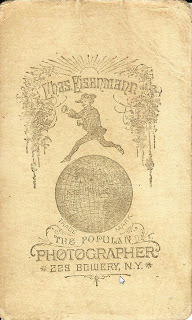Although torn at the bottom and with a small stain this cabinet card of an 1880's couple taken in Deadwood, Dakota Territory was a great find and it opened up a real research adventure for me. The photo shows an attractive well dressed man and woman, husband and wife, he is sitting and she is standing behind him. She is wearing the typical 1880's style bustled dress. She also has a beautiful, but common for the times, locket around her neck and her hair is styled with curly fringes about the forehead. The photographer was Pollock, Main and Gold Sts. Deadwood Dakota. On the reverside side the man is identified as "one of the Duggan sons of Henry Duggan, Sr. (Wm. Von Pier?)."
I am convinced that this is William V. Duggan who I found quite easily on Ancestry.com born in Barclay, PA most likely in December of 1855. His parents were Henry and Ann (unknown) Duggan both from Wales. Henry Duggan of Barclay, PA had seven sons, the oldest William being born in 1855. The next son was Henry Pierre born in 1868. In the 1880 Barclay, Bradford County, PA census 25 year old William is living with his parents and numerous brothers and sisters and occupation listed as student. Sometime around 1883 he married Mary (unknown) also from Pennsylvania, and before 1884 they moved to the South Dakota Territory where they are found in the 1885 South Dakota Territorial Census. Their son William Jennings Duggan was born 13 May 1884 (1900 Pipestone, Minnesota census). William age 30 listed his occupation as "lawyer, wife Mary age 23, with one son William age 1/12 (one month) and one servant, Lizzie Janes aged 14. His brother, Henry Pierre who was thirteen years younger did not marry until 1896 so they style of dress worn by the woman in this photo does not fit, therefore I am certain this is William V. and Mary Duggan.

Wiliiam and Mary would go on to have two more children, Ruth born in 1889 and Mary J. born in 1891. Mary must have died before 1893, perhaps in childbirth with Mary because on 11 Apr 1893 in Pipestone, Minnesota (just across the state line from South Dakota) William was married again to Georgia Hatch (1871-). William and Georgia lived in Minnesota until 1910 where they are listed in the 1910 Elkton, Brookings, South Dakota census. His occupation changed a little with each census, 1900 - insurance, 1905 - life insurance agent, 1910 - hotel ?, 1920 - life insurance. I wonder what led him to leave his law practice? William died 27 May 1932 in Brookings, South Dakota .
To further help date this photograph I found this helpful information on the photographer: In December 1884 Albert Pollock Studio was advertising their "elegantly tinted cabinet photo and walnut frame." Albert Pollock was partners with E. L. Boyden who bought him out in 1886 and Pollock retired to ranching. This information comes from the site,
http://identifythisdeadwoodimage.blogspot.com which has many wonderful old images from Deadwood. Since I know that William and Mary were married sometime around 1883 this photograph can be dated between 1883 - 1886.
Deadwood, the county seat of Lawrence County has such a rich history. According to Wikipedia it was named for the dead trees found in its gulch. The settlement of Deadwood was founded in the 1870's and has been described as illegal, since it lay within the territory granted to Native Americans in the 1868 Treaty of Laramie. In 1874
Col. George Armstrong Custer led an expedition into the Black Hills belonging to the Lakota and announced the discovery of gold on French Creek triggering a gold rush. This gave rise to the lawless town of Deadwood which quickly reached a population of about 5,000. Many prosperous businesses sprang up including saloons and brothels. The town attained notoriety for the murder of
Wild Bill Hickok and he is buried there at
Mount Moriah Cemetery as is
Calamity Jane.
A fire on September 26, 1879 devastated the town, destroying over 300 buildings and consuming most everything belonging to the townspeople. Many left to try their luck elsewhere. The Deadwood Central Railroad was founded in 1888 to serve the mining purposes of J.K.P. Miller and associates. Although electrified in 1902 for operation as an interuban passenger system, the railroad was abandoned in 1930.
Another fire in 1959 came close to destroying the town; about 4,500 square miles were burned. In 1961 the entire town was designated a National Historic Landmark. Today the population of Deadwood is around 1,270.
















































